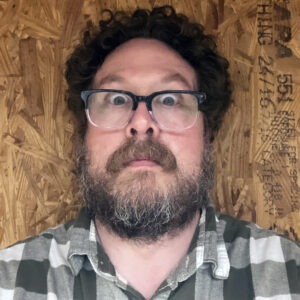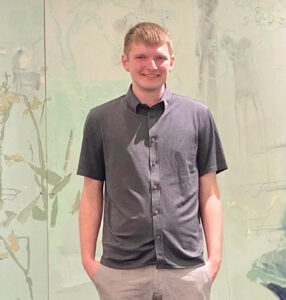
The Refract exhibition features new work by second-year MFA candidates: Austin Lewis, Mckee Frazior, Raul Rodriguez and Eli Ruhala. Artwork by Raul Rodriguez.
The Art Galleries at TCU proudly present “Refract,” a group exhibition featuring new work by second-year MFA candidates: Austin Lewis, Mckee Frazior, Raul Rodriguez and Eli Ruhala. The exhibition will be on view from Friday, Jan. 19 to Friday, Feb. 2 at Fort Worth Contemporary Arts Gallery. We spoke with the artists about their new exhibition featuring sculpted forms, narrative photography, interactive video and immersive installations.
Artist Talk

Mckee Frazior
How has this group exhibition contributed to your individual artistic growth and development?
Frazior: We each tried something different for this show and pushed to explore things we had never tackled before. Seeing one another explore like that, whether through medium, installation or even looking at different ways to push our current inclination, allowed us to be more comfortable and braver in trying out riskier projects.
Ruhala: In our shared journey through candidacy, we felt a certain expectation to demonstrate the values of our time here. Pursuing an MFA should entail transformation and growth, I believe the overarching thread in our growth has been in handling more complexity and managing numerous aspects, surpassing our initial expectations. This experience has equipped us to work around limitations and focus on what is best for the art.
Rodriguez: The exposure to different approaches, techniques and subject matters within the group inspired new ways of thinking and creating. The opportunity to display work that takes risks brought out the best in each MFA candidate. The topics we take on provide a peek into the inner workings of our individual pursuits. However, the works speak collectively in their own way, which was not planned but resulted in a cohesive and dynamic interconnectedness for the viewers.

Eli Ruhala
Where do you source material for your work, and what theme(s) do you primarily explore?
Ruhala: My material for “Refract” was derived from personal experiences. I worked with materials that my stepdad used to construct an installation where relationships are reflected upon. The theme for my piece is “standing in” love, and the installation is a result of the love of my life and the discipline it takes to work for that.
Rodriguez: As a narrative photographer, I delve into various themes such as personal history, underrepresented histories and cultural themes. My current research is on the Bracero Program, a landmark initiative shaping the socio-economic landscape of Mexico and the United States from the 1940s to the 1960s. Through images, I aim to convey the human stories behind the historical facts, bringing forth the emotions, struggles and triumphs of those who navigated the complexities of migration and labor. Ultimately, my research aims to contribute to a nuanced understanding of the Bracero Program, fostering dialogue on its historical significance, social implications and enduring legacy that continues to shape history.
Frazior: Most of my sources come from reading and growing up alongside internet culture and technology. My part of the exhibition relies heavily on a book by Kevin Kelly called “What Technology Wants.” He casts technology as an evolutionary agent that coexists with us as we reshape it, and it reshapes us. I’m drawn to the outer edges where fundamentally different systems and rulesets collide, creating chaos and order simultaneously. I find that having an interactive component helps me generate dialogue with the audience where they can explore along with me.

Raul Rodriguez
What do you hope viewers take away from the exhibition?
Rodriguez: In a group exhibition where diverse artistic voices converge and refract, I hope viewers will experience the power of artistic dialogue, finding connections and resonances that transcend the individual narratives presented.
Frazior: I hope viewers learn more about where they feel technology and culture work and don’t work for them. There is not a specific takeaway, but I hope they engage in this meditation on how technology and humanity shape one another concurrently and where they feel that is beneficial or problematic.
Ruhala: I hope that people viewing this exhibition can take away the understanding that reflection is an effort. Although we have invested a lot of ourselves in the work, we unanimously decided to leave out the details of our own lives. The result is that as a viewer, you get to carry your own details with you.
What advice would you give to students in the School of Art?
Frazior: The hardest thing in any medium is pushing through your ideas to see where they go. I would also encourage students to see more art and find their community, whether it be students here on campus or groups outside of the university. DFW has many great artists who work in different veins, so don’t be afraid to go out and meet them!
Ruhala: My advice to students in the School of Art would be to establish a clear goal and motivation for what you want out of art. Goals and ambitions can become diluted when we convince ourselves that we can do it all.
Rodriguez: Success in the arts often requires dedication and hard work. Cultivate a disciplined work ethic, set realistic goals and consistently invest time in your craft. Don’t be afraid to explore new mediums, techniques and styles. Experimentation is key to discovering your artistic voice and expanding your creative horizons but do so in a measured way while reinforcing your strengths. Or dive in unregulated and see what happens. Your work picks you, not the other way around.
